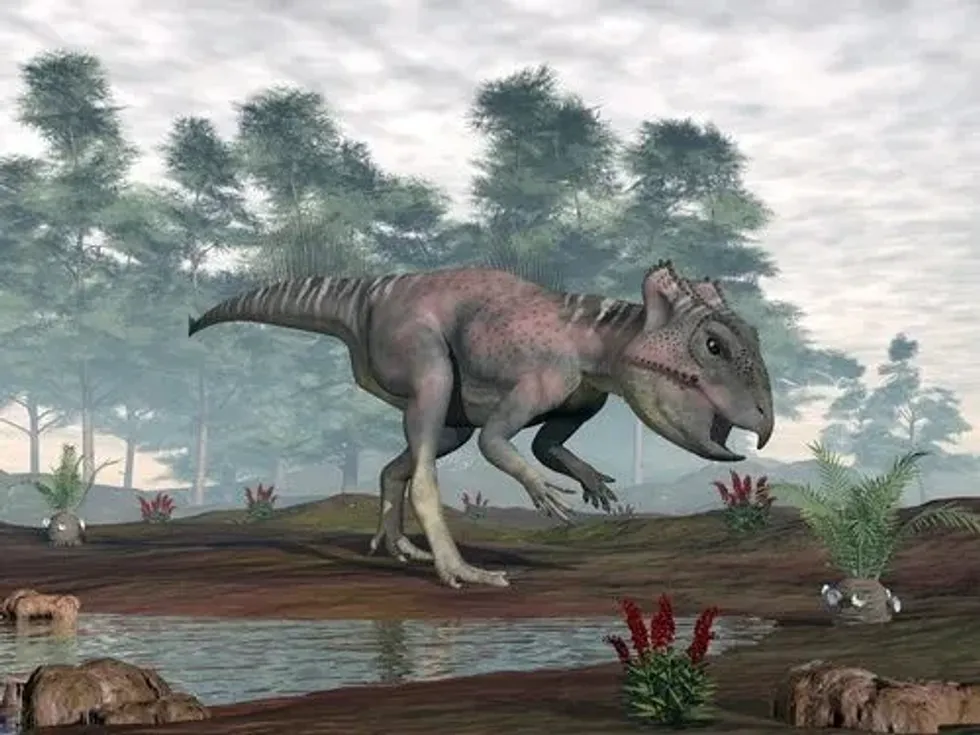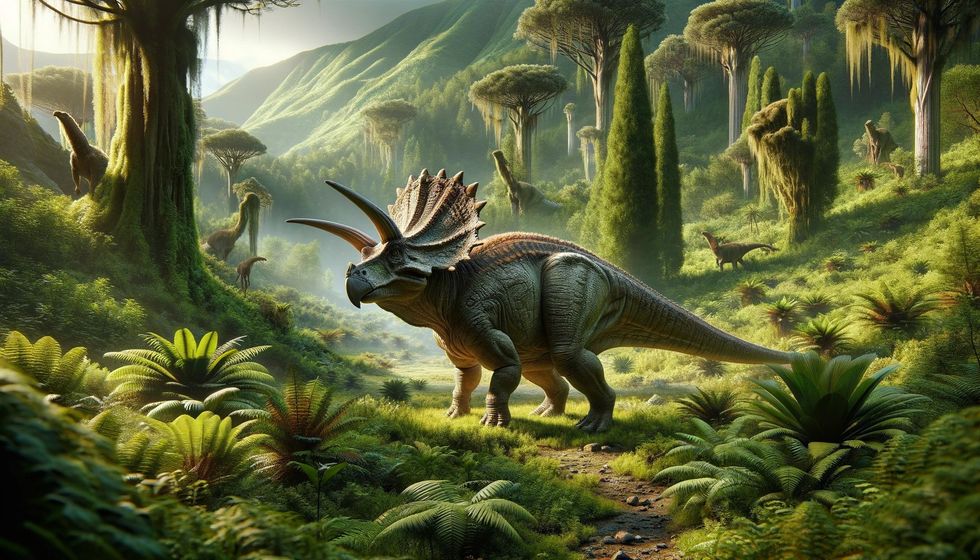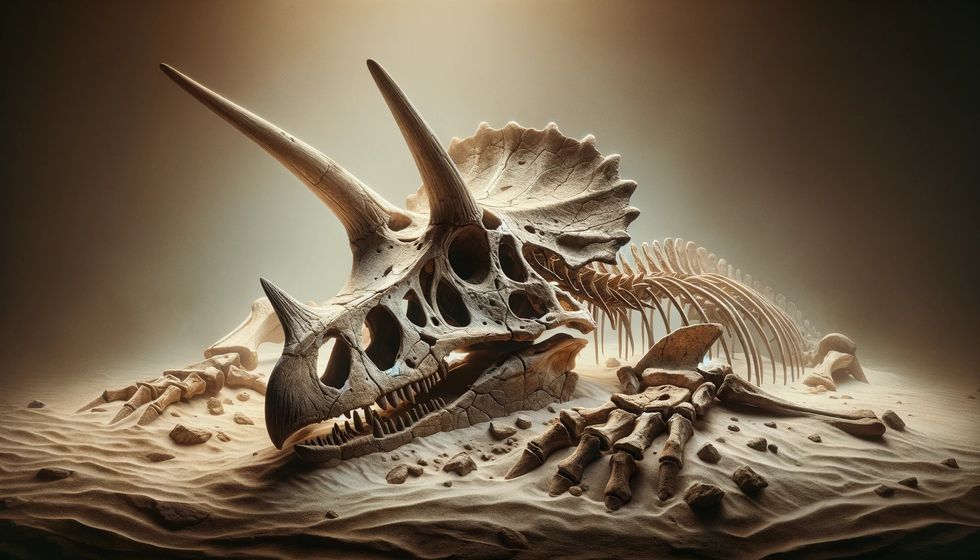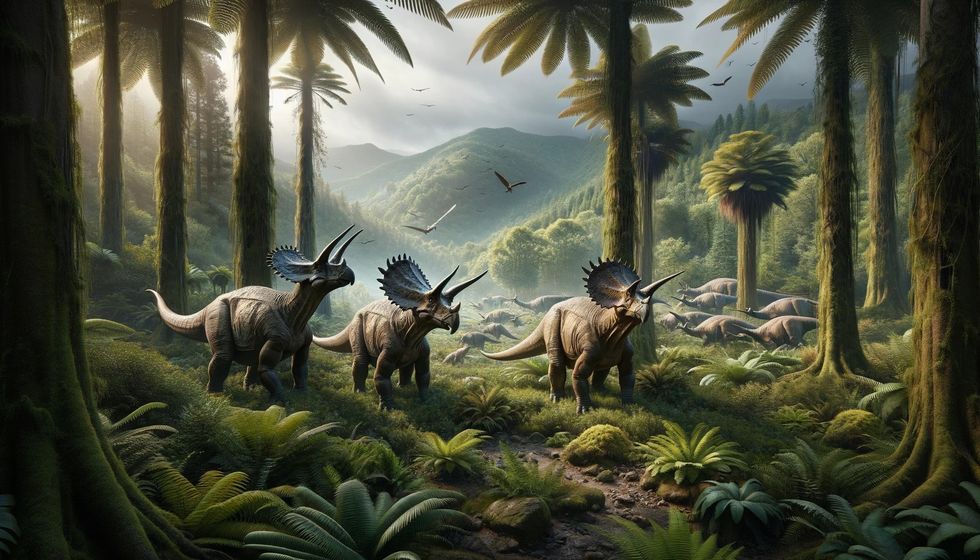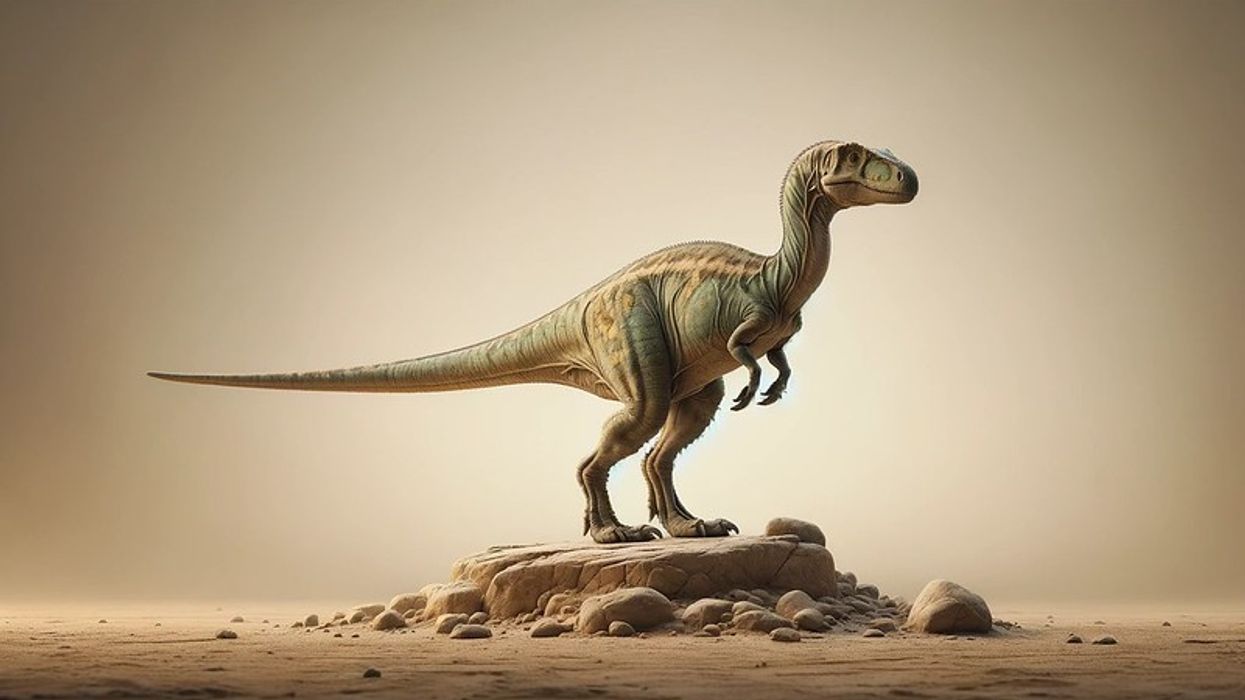TriceratopsChina
The Archaeoceratops stands as a testament to the diversity of prehistoric life that once thrived on the planet. Bearing the evocative name, which means 'ancient horned face', this genus of early-horned dinosaurs provides a window into the evolutionary journey of the ceratopsian lineage.
Dating back to the Early Cretaceous Period (approximately 145-100.5 million years ago), these formidable herbivores once roamed the vast landscapes of what is now known as the Mazongshan area in the Gansu Province of China.
The pivotal discovery of this dinosaur was accomplished by the collaborative efforts of the Sino-Japanese Silk Road Dinosaur Expedition, an undertaking that has contributed significantly to the understanding of dinosaur biodiversity and paleoecology during the Cretaceous Period.
The region where its fossils were uncovered is of particular paleontological interest, as it was part of an ancient environment that fostered an abundance of distinctly varied dinosaur species.
As one of the earlier members of this family, this dinosaur exemplified the developmental stages that would eventually give rise to more complex ceratopsians, creatures that fascinated public consciousness with their horns and extensive frills.
The existence of these herbivorous dinosaurs in such early geological strata underscores the profound complexity of evolutionary patterns and life's adaptability to the Earth's changing surface.
Despite its smaller size and comparatively modest frill, it was an important indicator of the ecological niches occupied by ceratopsians at the time.
Their skeletal structure, dental arrangement, and the surrounding flora and fauna found in conjunction with their fossils all contribute to an encompassing picture of the ecosystem dynamics in ancient Gansu Province.
Researchers continue to piece together the lifestyle, social behaviors, and potential threats these creatures faced, drawing from each new fossil discovery to refine interpretations.
Archaeoceratops Interesting Facts

How do you pronounce 'Archaeoceratops'?
The name Archaeoceratops is pronounced 'AR-kee-oh-SER-uh-tops'.
What type of dinosaur was it?
The Archaeoceratops was a basal neoceratopsian dinosaur, part of the family that later included the well-known larger horned dinosaurs like Triceratops.
In which geological period did this dinosaur roam the Earth?
Archaeoceratops lived during the Early Cretaceous Period (about 145-100.5 million years ago).
When did the Archaeoceratops become extinct?
Archaeoceratops became extinct by the end of the Early Cretaceous Period, although the precise time of their extinction is not known.
Where did this dinosaur live?
This dinosaur lived in what is now North-central China, notably in the Gansu Province.
What was their habitat?
Its habitat consisted of low-growing vegetation.
Who did they live with?

The Archaeoceratops’ cohabitation with other herbivorous and predatory dinosaurs is not definitively documented. Ongoing and future research may uncover more concrete information on the community of dinosaurs that existed in this region alongside the Archaeoceratops.
How long did an Archaeoceratops live?
The exact lifespan of the Archaeoceratops remains unknown. Further research is necessary to understand the lifespan of Archaeoceratops and the ecological factors that may have influenced it.
How did they reproduce?
As with many dinosaurs, Archaeoceratops likely laid eggs.
Archaeoceratops Fun Facts
What did they look like?
Archaeoceratops had a comparatively large head although it lacked horns, a sharp beak, and a small bony frill projecting from the back of its skull.
How many bones did an Archaeoceratops have?

The total number of bones in the Archaeoceratops skeleton is currently unknown due to the partially complete skeleton. Only a partial skeleton has been studied by researchers. Further discoveries are needed to provide a complete understanding of its skeletal structure.
How did they communicate?
The communication methods of Archaeoceratops remain undocumented. Continued research may shed light on this aspect of its behavior.
How big was the Archaeoceratops?
The Archaeoceratops measured about 3 ft (0.9 m) in length.
How fast could this dinosaur move?
The speed at which Archaeoceratops could move has not been established from available data. Further research is required to determine this aspect of the dinosaur's capabilities.
How much did an Archaeoceratops weigh?
The Archaeoceratops is estimated to have weighed approximately 22 lb (10 kg).
What were the male and female names of the species?
There were no specific names assigned to the sexes of this species.
What would you call a baby Archaeoceratops?
Baby dinosaurs, in general, are often referred to as hatchlings or juveniles.
How aggressive were they?
There is no available information on whether the Archaeoceratops exhibited aggressive behavior. Research into its behavior is ongoing and may reveal more about its temperament in the future.
Did You Know…

This stands out as an early example of basal neoceratopsians, highlighting its discovery as pivotal for understanding the initial evolutionary phases of the Neoceratopsia group.
The Silk Road Dinosaur Expedition was instrumental in uncovering these significant fossils. Unearthed within the Middle Gray Unit of the Xinminbao Group, these finds have markedly advanced the knowledge of the Cretaceous Period and the evolutionary branching of herbivorous dinosaurs.
The Mazongshan area, Gansu Province, China, is a region of immense paleontological significance due to its rich repository of dinosaur fossils.
This locale has been the site of numerous significant discoveries, among which is the unearthing of this dinosaur, a genus that sheds light on the evolutionary history of early ceratopsians.
The importance of the Mazongshan area stems not only from the fossils found within its boundaries but also from the insight these findings provide into the ancient ecosystems that prevailed during the Early Cretaceous Period.
It also underscores China's critical role in the field of dinosaur paleobiology and contributes to the broader understanding of prehistoric life on Earth.
The uncovering of this prehistoric creature signifies a remarkable discovery within the rich tapestry of dinosaur evolution, serving as the first basal neoceratopsian discovered.
This pivotal event has shed light on the early stages of neoceratopsian development, illustrating the primitive features that would later evolve and diversify into more complex forms in this dinosaur clade.
The term 'basal' indicates that this dinosaur occupies a position near the foundation of the neoceratopsian family tree, offering researchers a glimpse into the ancestral characteristics of this group during the Early Cretaceous Period.
As regards classification, Archaeoceratops belonged to a group of early ceratopsian dinosaurs known for their distinctive skull features and herbivorous diet.
As a basal member of the neoceratopsians, the Archaeoceratops provide critical insights into the phylogenetic branching and diversity that characterized this clade during the Early Cretaceous Period.
Understanding the classification of this dinosaur helps paleontologists trace the evolutionary lineage of horned dinosaurs and elucidates the morphological changes that occurred over millions of years.
The name 'Archaeoceratops', meaning 'ancient horned face', provides a descriptive insight into the distinguishing characteristics of this genus of basal neoceratopsians.
This nomenclature reflects the ancestral traits of the ceratopsian lineage, marked by a distinct facial structure that includes a beak-like mouth and a rudimentary frill. The name itself underscores the primordial nature of this dinosaur within the context of ceratopsian evolution.
The identification of species within the genus Archaeoceratops has deepened the understanding of dinosaur phylogeny, particularly within the neoceratopsians.
These revelations are crucial for constructing the evolutionary timelines and tracing the diversification of species that descended from these ancient ancestors.
The discoveries have also provided important context for how these species interacted with their environment and adapted to changing ecological conditions during the Early Cretaceous Period.
The discovery of an incomplete skeleton of this creature has presented paleontologists with both a valuable resource and a challenge.
This partial framework has been instrumental in piecing together the physical structure and lifestyle of the species; yet, due to its incompleteness, it also leaves many aspects of the dinosaur's anatomy and behavior open to interpretation, spurring ongoing research and examination.
Despite these gaps, the skeletal remains have been crucial in affirming the dinosaur's status as an early representative of the horned dinosaurs, shining a light on the formative stages of ceratopsian evolution.
FAQs
What was its habitat?
The Archaeoceratops roamed the earth in the Early Cretaceous Epoch, notably during the Aptian stage, in regions of what is recognized today as north-central China.
This dinosaur's terrestrial surroundings at the time were still new to the advent of flowering plants, with such flora being somewhat scarce in the area.
Found primarily in the Gansu Province of China, where its remains have been unearthed, the Archaeoceratops would have encountered a landscape populated with diverse, yet low-growing vegetation, given that grasses were yet to appear on the evolutionary scene.
As a herbivorous species, it is assumed that the Archaeoceratops fed on these low-lying plants.
What family are horned dinosaurs in?
Horned dinosaurs are classified under the Ceratopsidae family, a diverse assemblage within the ceratopsian order that boasts famous representatives such as Triceratops, Centrosaurus, and Styracosaurus.
These prehistoric creatures are distinguished by their prominent beaked snouts, a series of chopping teeth towards the rear of their jaws, pronounced nasal horns, and a fril, a slender, bony extension that projects from the rear and upper portion of the skull.
This family is organized into two principal subfamilies: the Chasmosaurinae, noted for their elongated, triangular frills and pronounced brow horns.
The second is the Centrosaurinae, recognized by their sizeable nasal horns or protuberances, shorter, boxier frills, and the ornamental spines that adorn the rear margin of the frill.
What is the difference between a Protoceratops and a Triceratops?
The ceratopsian family includes both Protoceratops and Triceratops, yet they exhibit notable differences.
The smaller Protoceratops measured between 6.6–8.2 ft (2-2.5 m) in length and tipped the scales at roughly 137–229 lb (62–104 kg), in stark contrast to the much larger Triceratops, which could stretch up to approximately 30 ft (9 m).
Unlike the Triceratops, renowned for its three prominent, developed horns, sometimes extending almost a meter, the Protoceratops had more subdued horn structures.
While Protoceratops did possess a fully formulated frill, it paled in intricacy compared to the Triceratops' decorative frill, adorned with a sequence of bony protuberances and possibly serving functions from visual displays to protection.
As a species, Protoceratops is recognized as an earlier, more basal branch of the ceratopsian family tree, potentially a forebear to later, more specialized ceratopsids like Triceratops.
This evolutionary chronicle positions Protoceratops as deriving from ancestral ceratopsians, while Triceratops emerged as one of the final and most formidable ceratopsian lineages.
Protoceratops roamed the Earth in the Late Cretaceous, around 75 to 71 million years ago. Triceratops came onto the scene approximately 75 million years ago and persisted until the Cretaceous Period drew to a close, around 66 million years ago.
What dinosaur has three horns?
The Triceratops, a dinosaur celebrated for its trio of horns, derives its name from ancient Greek, with 'trí' (τρί-) for 'three', 'kéras' (κέρας) for 'horn', and 'ṓps' (ὤψ) for 'face', combining to define it as the 'three-horned face'.
As a distinctive member of the Ceratopsidae family, this group comprises various horned dinosaur species, each boasting individual traits. The Triceratops is particularly renowned for its three formidable horns and the conspicuous large bony frill adorning its head.
The Archaeoceratops stands as a captivating subject in the study of the evolution of horned dinosaurs. The available skeletal fragments, though incomplete, are invaluable in deepening the understanding of the early ceratopsians' physical traits and possible behaviors.
Published documentation by the China Ocean Press, including information on the dinosaurs unearthed in the Mazongshan area of Gansu Province, China details the efforts of the Sino-Japanese Silk Road Dinosaur Expedition in discovering dinosaurs.
Related Articles Around the Web


